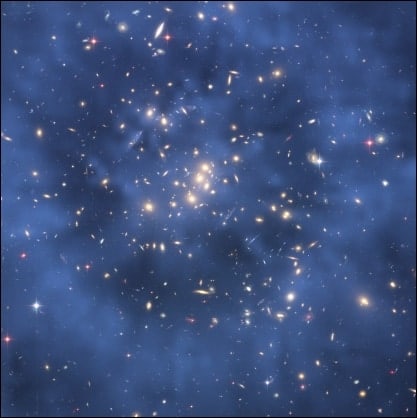In the vast expanse of the cosmos, luminous galaxies abound, yet they are enveloped in an enigmatic veil—dark matter. The very fabric of our universe is intertwined with this elusive entity that seemingly exists in a specter-like form, compelling astrophysicists to ask: What if the ghosts of the cosmos hold keys to understanding the fundamental composition of the universe? Recent astronomical discoveries, including the phenomenon often referred to as the “ghostly ring,” have invigorated discussions surrounding the nature and evidence for dark matter.
At the crux of exploring dark matter is the growing body of evidence revealing discrepancies between observed gravitational forces and the expected behaviors of visible matter. Over decades, astronomers have encountered anomalies in the rotation curves of galaxies; they spin much faster than would be predicted by their visible mass alone. This fundamentally suggests that an unseen mass—dark matter—fills the void, exerting gravitational influence. This leads to an intriguing question: If one could visualize dark matter, would it resemble a ghostly apparition, forever eluding our grasp?
The ghostly ring, central to recent findings, is a striking example of the indirect evidence supporting dark matter’s existence. This enigmatic ring structure appears in the observations of merging galaxy clusters, wherein the gravitational lensing effect allows scientists to map dark matter’s presence. As galaxy clusters interact and collide, they produce shock waves and cosmic filaments that can distort the background galaxy’s light, resulting in rings or arcs. By analyzing these images, researchers can infer the distribution of dark matter within these clusters.
To comprehend this phenomenon, it is imperative to delve into gravitational lensing, a pivotal concept emerging from Einstein’s theory of General Relativity. Gravitational lensing occurs when a massive object—such as a cluster of galaxies—warps the fabric of spacetime, bending the light from distant sources. This elegant prediction has been remarkably validated through numerous observations. The ghostly ring structure further typifies how gravitational lensing can unveil the presence of unseen matter surrounding a galaxy cluster, bolstering the argument for dark matter’s crucial role in cosmic evolution.
One challenge that arises from interpreting the ghostly ring is rooted in the methodological approach to delineating dark matter’s properties. The term “dark matter” encompasses a spectrum of possibilities, from Weakly Interacting Massive Particles (WIMPs) to more exotic candidates like axions or sterile neutrinos. Each class of hypothetical particles conjures distinct characteristics and behaviors, leading to diverse expectations in terms of interactions and distributions. How do researchers reconcile various dark matter models with the observational evidence provided by phenomena such as the ghostly ring?
As we navigate through the complexities of dark matter theories, the potential for misinterpretation looms large. The scientific community has yet to converge on a consensual framework. One proposes that the ghostly ring not only serves as a testament to dark matter but also invites skepticism about potential alternatives. Could modifications to General Relativity, rather than invoking exotic particles, explain the anomalous rotational curves and lensing effects? This enters the realm of modified gravity theories, such as MOND (Modified Newtonian Dynamics), which postulate deviations from classical gravitational laws under specific conditions. The perennial nature of scientific inquiry compels the community to explore every avenue before establishing definitive conclusions.
In expanding the dialogue on dark matter, one cannot overlook the role of observations from facilities like the Hubble Space Telescope and the upcoming James Webb Space Telescope. These instruments promise to enhance our understanding of galaxy formation and the cosmic web’s architecture. The ghostly ring phenomenon, observed in merger events, provides a connecting strand within the grand narrative of cosmic evolution, further urging astronomers to meticulously scrutinize the structures of the universe.
Moreover, collaborations between theorists and experimentalists provide fertile ground for potential breakthroughs. The burgeoning field of direct and indirect detection experiments aims to unearth the elusive dark matter particles, relying on advancements in technology and methodology. These efforts include deep underground laboratories where sensitive detectors are poised to catch the faintest interactions between dark matter and baryonic matter. Each positive detection would offer a foundation for further exploration and refinement of existing theories.
In light of these developments, the question remains: How shall we position ourselves in the grand tapestry of cosmological inquiry? The ghostly ring challenges not only our particulate understanding of matter but also encapsulates the beauty of scientific exploration, marked by its uncertainties and ever-evolving nature. As dark matter remains an omnipresent puzzle, engagement with both classical and contemporary paradigms models a nuanced approach in the quest for comprehension.
In conclusion, the exploration of dark matter is punctuated by both substantial evidence and significant challenges. The ghostly ring serves as an emblem of this paradox, embodying the tensions that lie within scientific inquiry. As researchers unravel the intricacies of the universe, one thing remains certain: the quest for understanding dark matter not only expands our horizons regarding the cosmos but also deepens our appreciation for the mysteries yet unraveled.












